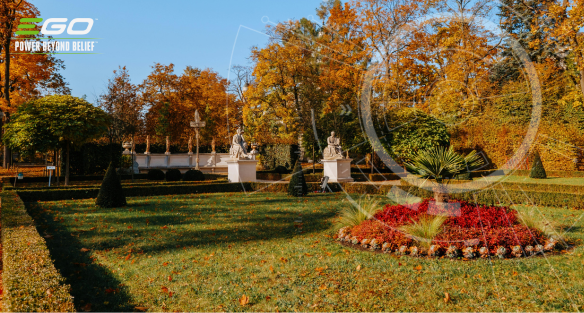Autumn lawn care should be carried out in September or October while the ground is still warm and there’s time for lawn recovery before winter. The mild and wetter conditions in autumn also favour grass and wildflower renewal.
Since the air’s cooler, it’s perfect for spending time in the garden and completing lawn maintenance. After carrying out your autumn lawn care, it should remain healthy over the winter. You’ll also see more benefits when the following growing season begins. The following guidance for autumn lawn care can be done in no particular order. It can be done all at once or in stages when you only have a bit of time here and there.
Scarify your lawn
You can use a rake or mechanical lawn scarifier for this job. When you’ve chosen which tool to use, first check if your lawn is ready for scarifying. To do this, start by pulling a rake or cultivator loosely through the turf. If the old grass cuttings and moss hang on to your tool, it’s time to scarify.
Another way to check is if there are many weeds in your lawn, which suggests that grass growth is inhibited by a lack of nutrients.
Now you’ve checked if your lawn is ready, follow these steps to scarify it:
- Make sure the lawn is mown before you scarify. It should be mown at a height of 2-3 cm.
- With a rake or scarifier, work your tool in one direction across the lawn and then at a right angle so you scarify in a ‘criss-cross’ fashion.
- After scarifying, apply lawn fertiliser and a top dressing to help it recover. You can do both with either sand, leaf mould or compost.
Trim the lawn edges
In the autumn, you should also trim the lawn edges. There are several good reasons to edge your lawn:
- It makes your lawn neat and tidy, creating curb appeal
- It helps to keep your walkways, flower beds and other areas that neighbour your lawn free of weeds
- It prevents cracks that are formed from the roots of weeds occurring in your walkways and driveways
- It makes a clear boundary between your lawn and flower beds
You can edge your lawn by hand, using either a half-moon edging tool (if you don’t have one, use a spade), the EGO Lawn Edger Multi-Tool attachment or even a cordless line trimmer. To edge your lawn, follow our steps below:
- Mow the grass first - Start by mowing the lawn so it’s easier to see where you’re working.
- Plan your new edges - You can either follow the established edge or create a new one. You can use string as a guide for straight lines, and a hose for curved ones. Then sprinkle sand over your guide so you have something to follow after you remove the string or hose.
- Begin edging - Following the planned path or established edge, begin edging either using a half-moon edging tool, the EGO lawn edger (you can read more information on how to use it here) or a line trimmer. If you’re using a line trimmer, ensure the cutting head can rotate so it cuts vertically. Read our blog on how to edge your lawn using a line trimmer for more information.
- Check for jagged and rough edges - Walk the new edge and inspect it carefully for jagged or uneven areas. If you find any, re-edge until you’re happy with the result.
- Clean up the edges and remove debris - After edging, you might find some grass overhanging the edge. You can trim these off with a pair of garden shears or carefully with a line trimmer. Remove any grass clippings and debris, like old turf, and compost them.
Break up compacted areas
You can tell if lawn areas are too compact if you notice bare patches of soil. Other times, there might be weeds growing that like compact ground, such as dandelions, knotweed, and plantain.
Once you’ve identified compact areas, you can break them up using a garden fork or a cultivator like the EGO Cultivator multi-tool attachment.
Apply some lawn feed
Feeding your lawn by top dressing in autumn is beneficial because it encourages your grass to grow healthy roots through winter. It also keeps your lawn healthy by giving it the nutrients it needs to fight winter grass diseases like Brown Patch. To top dress, you can feed it with one, or a mixture, of these natural fertilisers:
- Compost - Especially organic compost with plenty of decomposed organic matter like organic kitchen waste and grass clippings. Distribute the compost generously but evenly over the lawn using a spade or by hand. Aim for about 0.25-0.5 inches of compost top dressing.
- Manure like chicken manure or pellets - Apply this by hand and sparingly - you don’t need much, and it should tell you the correct application rate on the bag. Also, chicken manure is best applied in cool, wet weather to minimise the smell.
- Leaf mould - This is best applied after you have scarified your lawn, but it can also be done at any time in autumn. To use leaf mould as a top dressing, apply a thin layer over the lawn surface and brush it in. A great tool for this is the EGO Bristle Brush Multi-Tool attachment.
Browse the EGO gardening calendar for more garden tips
Our new gardening calendar is organised season by season. Now you know what gardening jobs need doing and when so you can have a healthy and thriving garden year after year.
Also, there’s plenty of information on how to maintain many of your EGO cordless garden tools as you go about your gardening throughout the seasons. Have a browse through, expand your gardening knowledge and put it into practice with the help of the EGO range.
